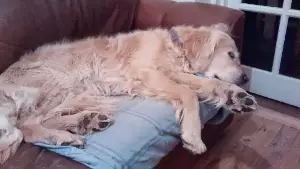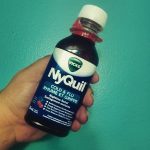
Even the best-trained, sweet-tempered dog has his limits.
The point where he draws the line.
For some it’s bathing time, while others will adamantly refuse to go to the vet or the grooming salon.
What do you do when you absolutely must get the dog into the car?
Drag the dog by the collar and risk having the whole neighborhood out in the street wondering who’s trying to kill the poor animal?
There has to be another way.
There are other ways to deal with such a situation.
There are certain sedatives you can use, but before we go on let us be clear on one point – never give your dog human tranquilizers or even drugs for veterinary use without talking to an expert first and making sure you know the correct dosage.
Also, you may want to check out natural remedies and relaxation techniques.
They won’t quite knock the dog unconscious, but they don’t have any side-effects.
What can you give a dog to sedate him?
There are various drugs you can use to sedate your dog, some more potent than others.
You should always try the least aggressive option.
If you need to calm down a dog before going on a car trip, you don’t really need to knock him out.
You only need him to be more relaxed and just a bit drowsy.
On the other hand, if you have a large dog that absolutely refuses to go to the vet and he definitely needs to go, then making use of a more potent sedative is in the dog’s best interests.
Let’s have a look at the available options.
Benadryl
Benadryl is an antihistamine, used to treat allergies in both humans and dogs.
It is one of the few over-the-counter drugs that can safely be used at home.
Many dogs with food allergies or skin problems are regularly prescribed Benadryl.
The active ingredient is diphenhydramine, which is a mild tranquilizer.
It won’t knock the dog out, but it will make him more mellow.
You can use Benadryl when you want your pet to be calm enough to allow you to give him a bath or try a nail trim, although it might not be enough for that.
According to experts, the correct dose for dogs is 2-4 mg per kilogram or body weight, or 0.9 – 1.8 mg per pound.
Just to be on the safe side go with a 1 mg per pound dose.
For a 25 pound dog a 25 mg pill should do the trick.
For a small dog, you should cut the tablet in half or use a 12.5 mg children’s Benadryl chewable tablet.
Do not use Benadryl syrup as most liquid formulations contain alcohol, which is toxic to dogs.
Also, keep in mind that on some dogs Benadryl might have the opposite effect, making your pet more agitated instead of calming him down.
Oral sedatives for dogs
This is the hard stuff, prescription-only sedatives, which can indeed knock a dog out for a couple of hours or more.
This category includes drugs such as:
- Acepromazine – this is a sedative commonly prescribed to dogs and it works by blocking certain receptors in the brain.
- Telazol – usually used in powder form, it is recommended as an anti-anxiety drug
- Diazepam – this is basically a sleeping pill
- Butorphanol – this is an opioid pain reliever
- Phenobarbital – this is often prescribed to prevent or treat seizures.
These drugs can be used alone or in various combinations, but only if and exactly how the doctor prescribes them.
Think carefully before asking the vet for a sedative.
All of them can have serious side effects.
Acepromazine, for instance, can cause low blood pressure or seizures.
Also, just like Benadryl it can have an unpredictable effect.
Some dogs might appear only mildly sedated, while others will be completely out for a few hours.
Given the choice, always try to assess the risk/benefits ratio. Is cutting the dog’s nail so important to risk giving him a seizure?
Melatonin
Melatonin is a hormone produced by the pineal gland.
People often use melatonin as a sleep aid, and experts agree it is also safe for dogs.
You can use melatonin to calm down a dog prone to anxiety attacks.
You can try it when prepping the dog for a trip or for a grooming session he doesn’t really care for.
Also, melatonin can be used to treat sleeping problems and hair loss.
Melatonin is available over the counter but make sure to check the ingredients list, as some formulas contain xylitol, which is toxic to dogs.
As for the correct dose, always check with your vet and read the label.
Generally speaking, 3 mg of melatonin is the dosage recommended for dogs up to 25 pounds.
For large breeds, you can use up to 6 mg. Melatonin can be given twice a day.
Although it’s considered a better option than many other drugs, melatonin can cause some side effects.
A melatonin overdose can cause vomiting, diarrhea, or even seizures.
Herbal remedies you can use to calm a dog
Before trying sedatives or anti-anxiety drugs, which, by the way, can turn your pet into a junkie, you should try a more gentle approach.
There are various plant-based supplements which have a calming effect and can be used to treat anxiety, hyperactivity and other behavioral problems in dogs.
They can also be used if your dog is scared by loud noises, such as fireworks, or becomes restless when it’s time for a family trip.
Valerian root
Valerian root supplements are considered safe for dogs, but you should refrain from giving them to a pregnant or nursing female.
This supplement is made from the root of Valeriana Officinalis, a plant native to Europe and Asia, known for its sedative effects.
It is available in a variety of forms, drops, tablets, tinctures, etc.
The recommended dose is 1 – 7. 5 grams (dried valerian root) and 7 – 15 milliliters (tincture).
Start with the lowest dose if you have a small dog and keep an eye on him. Valerian root will make a dog drowsy.
If you’re preparing your dog for a stressful event, start giving him valerian root a couple of days before to see how well he tolerates it and what effect it has on him.
Skullcap
Skullcap is also known as ‘mad dog weed’ as it was thought to cure rabies.
It doesn’t, but it does have a calming effect, and it doesn’t make a dog drowsy.
Skullcap is available in various pet formulations and some vets recommend it for epilepsy.
Check out the dosage recommended on the label or ask for your vet’s advice.
Keep the product out of your pet’s reach, as an overdose of Skullcap can cause stomach problems, confusion or seizures.
Skullcap can be used together with valerian root for better effects.
Pheromone-based calming collars
Pheromones are essentially hormones produced by all mammals.
For instance, a puppy can recognize his mother by the smell of the pheromones her body releases.
Look at pet stores or online for collars that release calming pheromones.
Buy your dog one a few days before the stressful event you need to prepare him for.
The calming effect of such collars, which sometimes also release essential oils, can last up to four weeks.
Aromatherapy
Another gentle way to calm an anxious dog is to use aromatherapy.
Lavender oil is the best and it is also to help relax humans, so why not give it a try with your dog?
Put a few drops of lavender oil on your hands and massage it gently into the dog’s fur, at the back of the head.
You can also put a few drops on the dog’s blanket. According to one study, lavender oil is quite efficient in easing a dog’s travel anxiety.
Make sure the dog doesn’t ingest the oil and it doesn’t get into the skin as it can be toxic.
How to use massage to help a dog relax
Don’t you feel totally relaxed after getting a massage?
Well, so will your dog.
You don’t have to take him to the spa.
This is something you can try at home.
Most dogs like it when you massage their ears, but there are also other pressure points you should focus on.
Try rubbing the spot right between and slightly above his eyes.
Apply just a little pressure and you will see the dog relaxing and even falling asleep.
Acupuncture also works, but you’ll need to locate an expert on that and, of course, you’d have to convince him to go there with you.
Can you use exercise to calm a dog?
Actually, that should be the first thing you try.
A dog that lacks exercise and mental stimulation is more likely to suffer from anxiety.
When you know you’ll have to get the dog in the backseat and drive for five hours straight make sure he gets to consume his energy.
Take him for a long walk, or as long as possible, get him to run around a bit, play a little Fetch game, and then get him into the car.
And don’t forget a nice chew toy to keep him busy for a while.
Closing Thoughts
Dogs suffer from anxiety, just like humans.
There are many things that can trigger an anxiety attack and make the dog agitated. If you talk to the vet.
He’ll probably recommend a sedative or an anti anxiety drug.
However, you should only use drugs as a last resort.
There are many other ways to calm a dog.
You can try melatonin or natural supplements, aromatherapy, calming collars, etc.
None of these will knock out the dog, but, at least, they don’t have dangerous side-effects.




